David Small’s Stitches
 August 24th, 2009 by jules
August 24th, 2009 by jules
Last year, Caldecott-Medal winner David Small was here for seven questions over breakfast, and he mentioned Stitches as one of his forthcoming titles, sharing this sketch here at that time (June ’08):
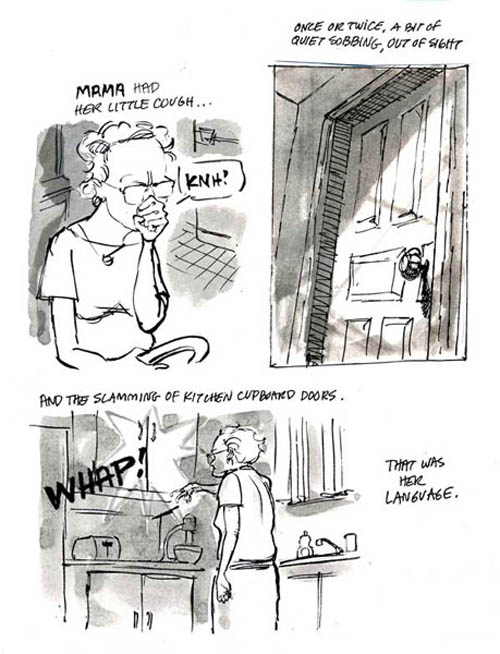
In today’s post are some panels from the completed book, his new graphic novel memoir for adults, to be released in early September from W.W. Norton & Company. The publisher likes to call it a “silent movie masquerading as a book” — and a tale of redemption, which it most certainly is. And one wrapped around my favorite theme, as I’ve said so often at the blog that you’re probably tired of reading it: The power of art to transform and heal.
But there are also some truly terrifying moments in this book of survival, including the ones pictured just below. The young David is six and has gone with his brother and mother to pick up their father at the hospital where he works. David’s wandered to the fourth floor and meets “the little man in the jar,” who later haunts his dreams:
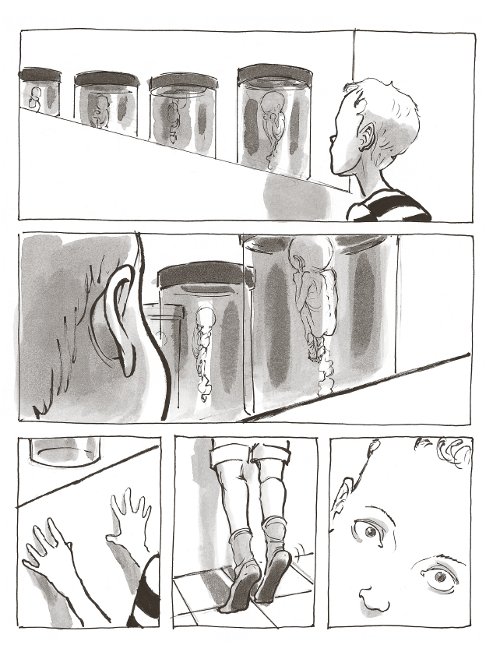

I’ve tried to tell a few folks lately what the experience of reading Stitches was like, and I’ve found it hard to describe. “Extraordinary. Just….extraordinary” is what I find myself stammering. {Note: Plot spoilers in this post.}

The first four pages of wordless panels show us Detroit. We get a panoramic view of the town, and then—as if a camera has zoomed tight in a film—we see the block where David lives, the street, the house, the door. Then, we enter the house, and lying on the living room floor, drawing The White Rabbit, is six-year-old David. The book’s first words, “Mama had her little cough,” gave me the chills. His mother, pictured in that sketch opening this post, was a woman of “furious, silent withdrawals” that “could last for days, even weeks at a time.” His father, a physician, is the kind of man who would go to the basement nightly and pound on a punching bag. “That was his language.” His brother would retreat, “beat on his drum.” And David? “…I, too, had learned a way of expressing myself wordlessly. Getting sick, that was my language.”
Born with sinus and digestive problems, David received care from his father, a radiologist. He would prescribe David’s medicines, administer shots, give him enemas, crack his neck (“our family nickname for the osteopathic manipulations he had learned in medical school”), and run the x-rays that were supposed to cure David’s sinus issues. “To me, Dad and his colleagues,” David writes, “seemed like the heroic men featured in the ads in Life magazine, marching bravely into the bright and shining future. They were soldiers of science, and their weapon was the x-ray.” A child who likes to imagine falling into his own drawings, David is anxious and repeatedly berated by his parents. His maternal grandmother, whom he visits one spring vacation with his mother, very obviously has an undiagnosed medical illness, even abusing David at one point during a disturbing and, needless to say, very intense moment in the book.
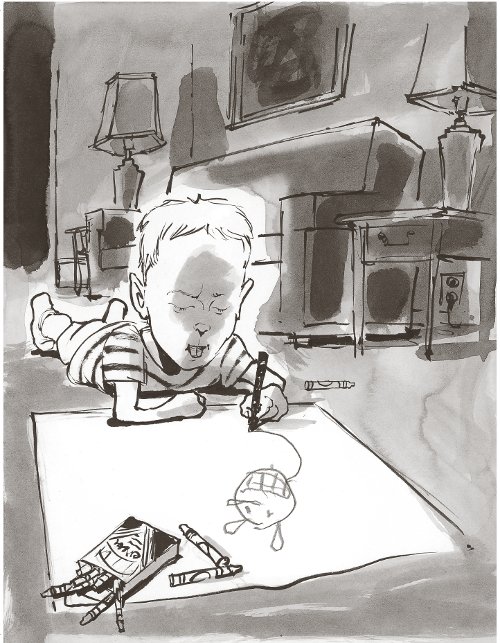
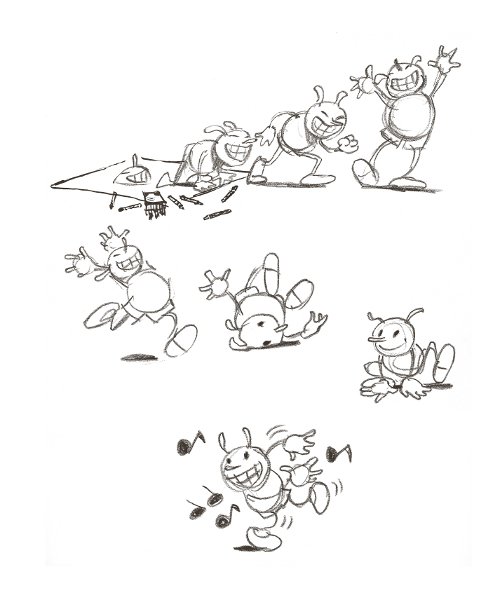
At the age of eleven, when a growth on David’s neck is spotted, it is diagnosed as a cyst by the family doctor, who recommends surgery. Three-and-a-half years after that diagnosis, David goes under, only to awaken with stitches on his neck and no voice. Trying entirely too hard to convince the mute David that everything will be allright, his father informs him there will be a second operation. David eventually goes home with a “crusted black track of stitches; my smooth young throat slashed and laced back up like a bloody boot.” This is one of the book’s many visually-arresting moments, David’s stitches morphing—in a series of drawings—into the steps up which his belligerent mother is tromping to write a note. Later, David finds this note: “Dear Mama, David has been home two weeks now. Of course the boy does not know it was cancer.”
I’m not making this up. I couldn’t if I tried. Neither could David.
Psychologically traumatized by this revelation, David begins to fall apart. When confronting his parents with the truth, asking if they have anything to say to him, his parents respond, “…you didn’t need to know anything then . . . and you don’t need to know about it now. That’s FINAL.”
I don’t want to give away the entire series of events here, but I will say that David, at the age of fifteen, is sent to a therapist (“It’s like throwing money down a hole, if you ask me!” his mother says, as she drops him off), who turns his life around. (“And so, we talked. After life in a house where silence reigned and free speech was forbidden, that office, three times a week, became a haven for me. There, things began to make sense…He treated me like a favorite son…He truly cared about me.”) David imagines him as the White Rabbit, having revealed earlier in the book that, as a child, he liked to “play Alice,” running around with a yellow towel on his head, trying to retreat into her magical world of “talking animals, singing flowers and dancing teapots”:

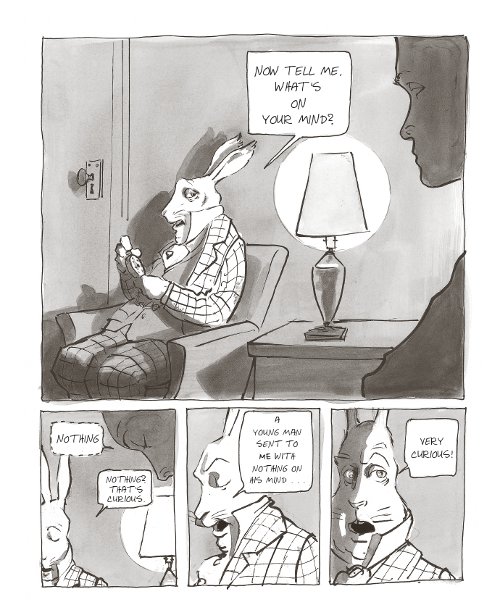
He presents David with a startling revelation, telling him the truth about his mother’s feelings for him — or lack thereof. (This results in another unforgettable series of wordless panels that last for pages and is a profoundly moving moment in the book.)
As David begins the work of pulling himself together, his family “seemed to be quickly falling apart.” David makes several stunning revelations about the members of his family, as well as his family as a whole. And, after his father reveals—with nothing at all resembling an apology—that he gave David cancer with the two to four hundred rads of radiation he gave him as a child, David moves out, still a senior in high school. “Art became my home. Not only did it give me back my voice, but art has given me everything I have wanted or needed since.”
The book’s final page is merely two words in an ample white space, but they mark a statement so emotionally compelling within the framework of David’s story that they moved me to tears. How David can manage to make two simple words so stirring and point us at the close of the book in a direction of hope is a testament to his talents. Bringing to mind—at least by way of technique—Sendak’s “and it was still hot,” also picture-less, I found it very moving.
If you read this blog regularly, you know I’m a Review Nerd and like to point out what the professionals have said about the book. These people say it way better than I possibly could: Publishers Weekly called it “profound and moving…Small tells his story with haunting subtlety and power”; Library Journal: “…{I}t’s Small’s art that lifts his memoir into the extraordinary. His seemingly simple black-and-white wash captures people, emotions, relationships, and plot subtleties with grace, precision, and a flawless sense of graphic narration…compelling, disturbing…”; Kirkus Reviews: An
“{e}motionally raw, artistically compelling and psychologically devastating graphic memoir of childhood trauma…Terse and unsentimental throughout, the narration becomes even sparer once the author loses his voice, with page after wordless page filled with stark imagery…Graphic narrative at its most cathartic”; and Booklist: “a frequently disturbing, pitch-black funny, ultimately cathartic story whose full impact can only be delivered in the comics medium, which keeps it palatable as it reinforces its appalling aspects. If there’s any fight left in the argument that comics aren’t legitimate literature, this is just the thing to enlighten the naysayers.”
The emphasis there on that last sentence is all mine.
This post was my attempt to get past the stammering, but I still say: This book is extraordinary. Be prepared: It may very well haunt you.
Note: Stitches has its own home in cyberspace. Go visit, if you’d like to see more of David’s art from the title.
Final note: Many thanks to David Small for helping me secure the art for this post and the publisher for sharing it. Here’s the necessary copyright information:
STITCHES. Copyright © 2009 by David Small. Published by W.W. Norton & Company, New York, NY. All rights reserved.

I am so looking forward to this and will get a copy when I get back to the States. David Small is a huge favorite at our house and I am thrilled that he is illustrating a book of mine,
ELSIE’S BIRD for Philomel. A dream come true.
Jane
Oh, wow. I am — gobsmacked by this, mainly because the life portrayed is much like the life of a person I know. I’m thrilled that he found a way to express this, and in graphic novel form — SCORE. Huge score. The wordlessness makes it awesome. Hope you cross-post this on GLW.
Jane, yeah. I’m a huge David fan, too.
Tanita, thanks. Good idea. I’ll bounce the idea off Colleen.
Okay, I just skimmed your review because the artwork was so compelling…I don’t want to know too much about the novel, I just want to read it! Jumping over to my library’s website right now to look it up. Love you, Jules!
*speechless*
What a great recap. I can’t wait to read this. Thanks!
As I was reading this I was thinking of the comment I would leave…but there were no words…then I scroll down here and see others were equally affected.
Like jama said…*speechless*
That last brilliant page reminded me of “and it was still hot,” too.
Even though the subject matter was difficult, this book left me feeling energized. It’s so filled with hope and healing.
Wow. Thanks for this, Jules. Will definitely be picking this up.
Oh my god. Putting this on reserve right now. It will clearly deserve a quiet block of reading time, not 5 minutes snatched here and there between chauffeuring and errands. Thanks, Jules. Sounds totally arresting.
Oh my god is right.
I’m sort of shivery about reading this book…
Really sort of shivery….
I thought I did.not.like. graphic novels at all until I read The Complete Persepolis and now I’m really open and ready for this…
I think.
Shivers.
I am definitely buying and reading it after your review. Thank you so much for the wonderful job you do with your blog. Greetings from Madrid, Spain!
Great write up. I’ve got a review of Stitches myself, up at chuckpalahniuk.net
http://thejamminjabber.com/2009/09/08/stitches-by-david-small/
David has that rare gift of conveying whimsy and dread. Cannot wait to read the final version.
Awesome book! I pre-ordered it the day you raved about it on your FB status. Then when this blog entry came, started to read your blog until you warned there were spoilers. Thanks for the warning! Finished the book last night , reading your review brings me to tears.
What a triumphant ending!
His drawings tied so many scenes together — going down the rabbit hole, the dreams, the psychiatrist.
Jules, be sure to tell me next time you run across a whopper of a book like this.
[…] first read about the book on the wonderful book blog Seven Impossible Things Before Breakfast. The review reminded me of Craig Thompson’s Blankets. I don’t know if they truly are similar, but […]
Just finished this haunting, searing memoir and your blog was just awesome, thanks for your words, thoughts and tremendous insights!
[…] 7 Impossible Things Citizen Reader Bermudaonion […]
[…] The Lion and the Mouse by Jerry Pinkney, Once Upon a Twice by Denise Doyen and Barry Moser, Stitches by David Small, and Funny Business: Conversations with Writers of Comedy by Leonard S. […]